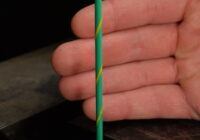
Mar 5, 2023
Intro to USE-2 Solar Cable
As society moves toward renewable energy and solar power, we need wires that can handle the unique demands of those applications. USE-2 (Underground Service Entrance) wire has stepped up to answer the call, as well as a few others.
USE-2 cables provide wide-reaching power distribution capabilities. You can find them rated for several different environments, but one of the most common uses is in photovoltaic power. They’re popular in this arena due to their approvals for direct burial, wet and dry locations, and high voltage ratings, among other properties.
Let’s take a closer look at USE-2 wire and see what it’s made of.
What Is USE-2 Wire?
USE-2 solar wire is a single-conductor electrical wire. It’s commonly used underground, with a temperature rating as high as 90°C and a voltage rating of 600 volts on all sizes.
USE-2 solar cable is rated for direct burial in the ground without conduit or raceway. It’s manufactured in flexible copper or aluminum strands, along with flexible rubber insulation. It was designed and engineered to be used for solar panel installations, with sunlight-resistant insulation available for direct burial.
These copper cables are a slight upgrade from a typical welding cable. Both are rubber-insulated, but the insulation of USE-2 offers better performance in abusive conditions. Welding cable is also very flexible and manufactured with thin copper strands and very bendable rubber insulation. USE-2 cable has approval from several different entities, including:
- UL LLC.
- The CSA Group.
- The Mine Safety and Health Administration (MSHA).
Welding cable does not have these approvals. Both are, however, compliant with the Restriction of Hazardous Substances (RoHS) directive, which means they are lead-free.
Types of USE-2 Solar Cable
There are two primary types of USE-2 wire, as well as an aluminum alternative:
- Cross-linked polyethylene (XLPE) insulation: The plastic, XLPE insulation is what provides flexibility and durability to the USE-2 wire. It helps to protect it from the elements, including water, chemicals and abrasion, and offers more longevity in harsh environments. The XLPE version comes in many different color options because it is easy to change the insulation dye color.
- Chlorinated polyethylene (CPE) insulation: This version of the USE-2 solar cable provides a rubber insulation. As changing colors is a sizeable undertaking with rubber insulation, you’ll typically only find CPE cables in black and sometimes red.
- Aluminum: Finally, we also offer a USE-2 aluminum cable, which is much cheaper and lighter than copper. Keep in mind that aluminum isn’t as conductive as copper, so the American Wire Gauge (AWG) size you choose will have to be slightly larger than the copper equivalent. For instance, a USE-2 2 AWG copper cable will translate into a 1/0 (0 AWG) aluminum cable, which is two sizes bigger. If you’re not sure what size you need, we’re always here to help.
If you don’t need approvals for solar photovoltaic (PV) or underground applications, we also offer the less-expensive thermoplastic, high-heat, nylon-coated (THHN) cable or cross-linked polyethylene high-heat-resistant and water-resistant (XHHW) cable.
RHH and RHW-2
RHH and RHW-2 are some acronyms you’ll likely see when looking for USE-2 solar cable. These refer to some attributes of the wire.
- RHH: An RHH-rated cable is one that has rubber insulation and high-heat performance up to 90℃. These cables are not water-resistant.
- RHW-2: With an RHW-2 rating, a cable has rubber insulation, can tolerate operating temperatures of up to 90℃, and displays moisture resistance and flame resistance.
You might find these ratings on XLPE cables to designate appropriate environments. Choosing the right RHH or RHW-2 rating is important for finding a cable that fits your needs without excessive costs. Remember that RHW-2 is different from RHW, which is only rated for operating temperatures of up to 75℃.
What’s the Difference Between USE and USE-2?
USE wire didn’t have the same 90℃-rating that USE-2 does. It typically had an RHW designation instead of RHW-2, meaning it was not moisture- or flame-resistant. Modern cable manufacturers make USE-2, as many consider USE to be obsolete.
USE-2 Underground Cable
One popular application for USE-2 cables is as underground cable. Many cables with similar capabilities won’t have the same underground ratings as USE-2. Some of the characteristics that make it suitable for underground burial include protection against:
- High heat.
- Wet, damp and dry environments.
- Abrasion.
- Sunlight.
- Pressure.
- Chemicals like oil and gas.
USE-2 solar cable is not rated for in-premise applications except for termination at the service point, as it isn’t tested for flame propagation properties. A similar option is welding cable, though that doesn’t have the range of approvals that USE cable does. If your application requires flame retardance, you may need to use something else. You can always contact us for help identifying the right cable for the job.
USE-2 Cable From WesBell Electronics
We stock USE-2 electrical wire in our New Hampshire warehouse for shipping throughout the USA. We have the ability to drop ship our USE-2 wire when necessary, along with XHHW and THHN cables.
When you shop with WesBell, you get exceptional service from industry experts alongside affordable prices, so you can get the job done without breaking the bank. We also offer a range of services for preparing cables for whatever your work entails.
Browse our USE-2 solar cable options today, or reach out to us if you have any questions about them or which cable is right for your application.






